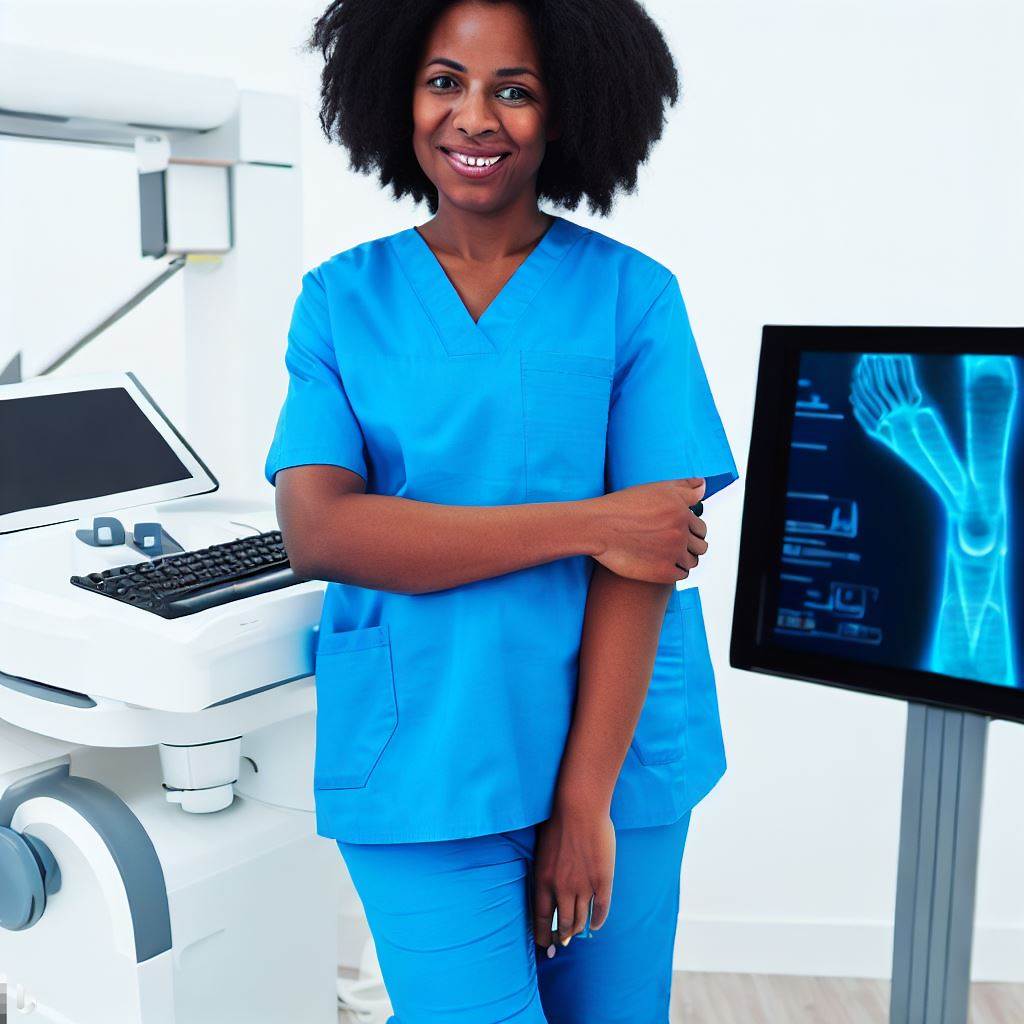Introduction
Podiatry and its role in healthcare
Podiatry is a specialized field of medicine that focuses on the diagnosis, treatment, and prevention of foot and ankle disorders.
Podiatrists, also known as foot doctors, play a crucial role in the healthcare system by ensuring the overall well-being of patients’ feet and lower limbs.
They deal with various conditions such as injuries, infections, deformities, and chronic diseases related to the feet and ankles.
Introduction to the impact of technology on podiatry in Nigeria
Technology has revolutionized the field of podiatry in Nigeria, bringing significant advancements in diagnoses, treatment procedures, and patient care.
With the introduction of advanced imaging techniques such as MRI and CT scans, podiatrists can accurately diagnose the root cause of foot and ankle conditions.
Advancements in telemedicine enable podiatrists to offer remote consultations, saving time and effort for patients and practitioners.
Additionally, the use of electronic health records and digital patient management systems has streamlined administrative tasks and improved the efficiency of clinics.
Moreover, state-of-the-art surgical instruments and equipment have enhanced the precision and effectiveness of podiatric surgeries.
Advanced prosthetic and orthotic devices have also improved the mobility and quality of life for patients with foot and ankle disabilities.
Technology revolutionized Nigerian podiatry, empowering podiatrists for superior patient care, precise diagnoses, and improved surgical results.
As technology continues to advance, the future of podiatry in Nigeria looks promising, with the potential for further innovation and improved healthcare outcomes
Traditional podiatry practices in Nigeria
Overview of traditional podiatry methods
- Traditional podiatry in Nigeria involves the use of natural remedies.
- Herbs, oils, and various traditional practices are used to treat foot ailments.
- Podiatrists in this field have passed down their knowledge through generations.
- They possess expertise in identifying and treating foot conditions using traditional methods.
- These traditional methods often involve a holistic approach to foot care.
- Podiatrists may also incorporate massages and special exercises into their treatment plans.
Challenges and limitations faced by traditional podiatrists
- One of the major challenges faced by traditional podiatrists is the lack of recognition.
- In Nigeria, traditional podiatry is not widely acknowledged as a legitimate medical practice.
- This lack of recognition leads to difficulties in acquiring funding and resources.
- Traditional practitioners may struggle to reach a larger audience due to limited exposure.
- They face challenges in competing with modern medical practices and technologies.
- The use of modern technology in podiatry has gained popularity and preference among Nigerians.
- Traditional podiatrists may face criticism for not adapting to modern advancements.
Despite these challenges, traditional podiatry methods still hold value in Nigeria.
They offer a unique perspective and alternative approach to foot care.
Some individuals prefer the holistic and natural remedies provided by traditional practitioners.
Traditional podiatrists play a significant role in preserving cultural heritage and passing down ancestral knowledge.
Efforts should be made to bridge the gap between traditional and modern podiatry practices.
Greater recognition and support can help traditional podiatry continue to thrive and meet healthcare needs in Nigeria.
Collaboration between traditional and modern podiatrists can lead to a more comprehensive approach to foot care.
By combining their expertise, both traditional and modern practices can benefit and complement each other.
Ultimately, the impact of technology on podiatry in Nigeria should not diminish the significance of traditional methods.
Both traditional and modern podiatry practices should be valued and respected for their contributions to healthcare.
Read: An Overview of Social Work Practices in Nigeria
The introduction and adoption of technology in podiatry
Explanation of the key technological advancements in podiatry
- Computer-Aided Design (CAD) technology has transformed the process of creating custom orthotics.
- Advanced diagnostic tools such as 3D scanners allow for more accurate foot measurements and analysis.
- Surgical robotics have improved precision and outcomes in podiatric surgeries.
- Telemedicine platforms enable remote consultations and follow-ups for patients in remote areas.
- Wearable technology, such as smart insoles, help monitor and track patients’ foot health.
Examples of technology adoption in Nigerian podiatry clinics
- Podiatry clinics in Nigeria now utilize CAD technology to design and manufacture custom orthotics tailored to patients’ needs.
- Specialized 3D scanners are being used to create precise digital foot models, aiding in the diagnosis and treatment planning.
- Robotic-assisted surgeries have been introduced in some Nigerian podiatry clinics, improving surgical outcomes and reducing complications.
- Telemedicine platforms are being implemented to bridge the gap between patients and specialists, particularly in rural areas with limited access to healthcare.
- Wearable technology, like smart insoles, is being recommended by podiatrists to monitor foot pressure and provide real-time feedback to patients.
The introduction and adoption of technology in podiatry clinics in Nigeria have revolutionized the field, enhancing diagnosis, treatment, and patient care.
Technological advancements have had a significant impact on various aspects of podiatry, ranging from orthotic design to surgical procedures.
Computer-Aided Design (CAD) technology has transformed the way custom orthotics are created.
This technology improves accuracy and reduces the margin of error in diagnosis.
Surgical robotics have also made a significant impact on podiatric surgeries in Nigeria.
Robotic-assisted surgeries enable enhanced precision and control, minimizing the risk of complications and improving surgical outcomes.
Nigerian podiatrists have embraced this technology, leading to improved patient satisfaction and faster recovery times.
Telemedicine platforms have emerged as a solution to the limited access to podiatric specialists in remote areas of Nigeria.
With telemedicine, podiatrists can remotely consult with patients, provide follow-ups, and offer guidance on foot care.
This technology greatly benefits rural areas, addressing transport and specialized healthcare access challenges faced by patients.
Read:The Future of Podiatry A Look at Nigeria’s Potential

Improved diagnosis and treatment through technology
Benefits of technology in podiatry diagnosis
- Enhanced accuracy in diagnosing foot and ankle conditions.
- Use of high-resolution imaging techniques for better visualization and identification of issues.
- Improved screening capabilities to detect diseases and disorders at an early stage.
- Reduced reliance on invasive diagnostic procedures, minimizing patient discomfort and risk.
- Access to comprehensive medical records and data for better analysis and diagnosis.
- Efficient tracking and monitoring of potential complications through digital tools.
- Seamless integration of diagnostic information with electronic health records, ensuring comprehensive patient care.
- Enhanced collaboration among healthcare professionals through telemedicine and teleconsultation.
- Increased patient engagement and education through interactive diagnostic tools and apps.
- Promotion of preventive podiatric care through early detection and targeted interventions.
Advancements in treatment options through the use of technology
- Introduction of minimally invasive surgical techniques for precise foot and ankle procedures.
- Use of robotic-assisted surgeries for greater surgical precision and shorter recovery times.
- Development of advanced prosthetic devices and orthotics for improved mobility and comfort.
- Integration of 3D printing technology to create customized orthotics and prosthetic limbs.
- Implementation of laser therapy for various podiatric conditions, promoting faster healing.
- Application of shockwave therapy for the treatment of chronic foot and ankle pain.
- Utilization of regenerative medicine techniques to promote tissue repair and regeneration.
- Access to remote rehabilitation programs through virtual reality and mobile applications.
- Improved patient outcomes and satisfaction due to advanced treatment options.
- Enhanced post-operative care through remote monitoring and digital patient support systems.
By embracing technology, podiatry in Nigeria has experienced significant advancements in diagnosis and treatment options.
The benefits of technology in podiatry diagnosis are vast. The accuracy in identifying foot and ankle conditions has greatly improved.
High-resolution imaging techniques enable better visualization, aiding in accurate identification of issues.
Moreover, technology has enhanced screening capabilities, enabling early detection of diseases and disorders. .
Minimally invasive surgical techniques have gained popularity, leading to precise foot and ankle procedures with minimal scarring and quicker recovery times.
Robotic-assisted surgeries offer greater surgical precision and further reduce recovery periods.
Advanced prosthetic devices and orthotics improve mobility and provide individuals with greater comfort.
3D printing technology has enabled the customization of orthotics and prosthetic limbs, enhancing their effectiveness.
Podiatrists can now implement laser therapy to promote faster healing and manage various podiatric conditions.
These technologies offer hope to patients with complex cases, providing them with improved treatment options and potential relief.
Read: Challenges and Solutions in Nigeria’s Social Work Practice
Telepodiatry Revolutionizing accessibility and healthcare delivery
About Telepodiatry And Its Benefits
Telepodiatry is a branch of telemedicine that focuses on providing podiatric care remotely through the use of technology.
It revolutionizing telecommunication by merging podiatry expertise, granting benefits to patients and healthcare providers.
One of the foremost advantages of telepodiatry is the increased accessibility to podiatric care.
Remote residents in Nigeria struggle to access specialized healthcare due to urban-centric facility concentration.
Telepodiatry closes gaps: Patients consult podiatrists via video, despite location constraints.
Furthermore, telepodiatry eliminates the need for physical travel, saving patients from the time and cost associated with transportation.
It also ensures that patients can receive timely care, particularly during emergencies or situations when immediate advice is required.
Telepodiatry enables patients to promptly receive diagnoses, discuss treatments, and follow up with podiatrists from home.
Additionally, telepodiatry contributes to the overall improvement of healthcare delivery in Nigeria.
By employing technology to connect podiatrists with patients, telepodiatry optimizes the use of healthcare resources.
It removes the necessity for extensive paperwork, lessens the healthcare professionals’ burden, and lets them concentrate on quality care.
How telepodiatry is improving access to podiatric care in remote areas
Telepodiatry has made significant strides in improving access to podiatric care in remote areas of Nigeria.
Technology empowers telepodiatry to surmount distance and infrastructure constraints, delivering podiatric care to underserved regions effectively..
In Nigeria’s remote areas, where access to specialized healthcare services is limited, telepodiatry acts as a lifeline for patients with foot and ankle problems.
It enables them to connect with experienced podiatrists from anywhere, eliminating the need to travel long distances for consultations.
This saves patients from financial burdens while opening doors to expert guidance and treatment options they would otherwise not have access to.
Moreover, telepodiatry facilitates continuity of care for patients residing in remote areas.
Podiatrists can remotely track patient progress, guarantee treatment plan adherence, and intervene promptly, all through virtual visits.
Patients no longer have to face interrupted care due to geographical barriers, empowering them to manage chronic conditions effectively.
Furthermore, telepodiatry has paved the way for knowledge sharing and capacity building among healthcare professionals in remote areas.
By connecting with podiatrists from urban centers through telecommunication, rural healthcare providers can enhance their skills and knowledge in podiatric care.
This, in turn, leads to the development of a more competent healthcare workforce capable of addressing foot-related issues in underserved areas.
Basically, tele podiatry is revolutionizing accessibility and healthcare delivery in Nigeria’s podiatry field.
This innovative approach breaks down traditional barriers, granting patients in remote areas access to specialized care.
Telepodiatry not only improves convenience and overall patient experience but also enhances healthcare efficiency by optimizing resources.
As technology continues to advance podiatry holds great promise for the future of podiatric care in Nigeria.
Read: Role of Family Therapy in Mental Health in Nigeria
Electronic Health Records (EHR) in podiatry
- Introduction to EHR and its advantages
- How EHR is enhancing patient record management and continuity of care
In the field of podiatry, the impact of technology has significantly revolutionized the way healthcare providers manage patient records.
Electronic Health Records (EHR) store a patient’s medical history digitally, accessible via computer systems, marking vital medical progress..
Introduction to EHR and its advantages
Electronic Health Records (EHR) have become a vital tool for podiatrists in Nigeria.
With EHR, healthcare providers can effortlessly record, update, and access patient information in a secure and centralized manner.
This digital transformation has several advantages over traditional paper-based records.
Firstly, EHR improves efficiency by eliminating the need for physical storage and retrieval of files.
Secondly, it enhances accuracy by minimizing errors typically associated with manual data entry.
Another advantage of EHR is its ability to facilitate interconnectivity and collaboration within the healthcare system.
Podiatrists can easily share patient information with other healthcare professionals involved in the patient’s care, such as primary care physicians or surgeons.
This seamless exchange of data allows for better care coordination, leading to improved patient outcomes.
Additionally, EHR enables healthcare providers to quickly access a patient’s medical history, which can be crucial for making informed treatment decisions.
How EHR is enhancing patient record management and continuity of care
EHR has significantly enhanced patient record management and continuity of care in podiatry.
Electronic systems store patients’ medical history digitally, allowing access to crucial medical advancements and progress via computers.
This comprehensive view of a patient’s medical information allows for better decision-making and personalized treatment options.
Electronic Health Records also contribute to improved continuity of care.
Podiatrists can easily access a patient’s past records and seamlessly continue their treatment from previous visits.
This removes patients’ need to repeat medical history, saving time and ensuring healthcare providers access all relevant details.
Moreover, EHR allows for real-time communication between podiatrists and patients.
Patients can securely access their health records online, allowing them to stay informed about their condition, treatment plans, and upcoming appointments.
This empowers patients to actively participate in their healthcare journey and make informed decisions about their treatment options.
The adoption of Electronic Health Records in podiatry has greatly impacted the healthcare landscape in Nigeria.
EHR has improved patient record management, facilitating better care coordination, and ensuring continuity of care.
EHR enhances podiatrists’ efficiency, accuracy, and connectivity. It offers a full patient history, involving patients in care.
Read: Public Health in Nigeria: Bridging the Gap in Care
Challenges and Barriers to Technology Adoption in Podiatry in Nigeria
Factors hindering the full implementation of technology in podiatry
- Limited access to advanced technological infrastructure and equipment.
- Inadequate funding and financial resources to invest in modern technology.
- Lack of awareness and understanding about the benefits of technology in podiatry.
- Inadequate training and skills development for healthcare professionals to utilize technology effectively.
- Poor internet connectivity and unreliable power supply hindering digital operations.
- Resistance to change and reluctance among healthcare providers to embrace technology.
- Lack of government policies and support to encourage the integration of technology in podiatry.
Strategies and Solutions to overcome these challenges
- Improving infrastructure: Invest in modern technology, equipment, and facilities to enhance podiatry services.
- Financial support: Allocate appropriate funds and resources to encourage healthcare institutions to adopt technology.
- Education and awareness programs: Conduct workshops, seminars, and educational campaigns to promote understanding of technology benefits.
- Training and capacity building: Provide comprehensive training programs to healthcare professionals on technological advancements.
- Improving connectivity: Enhance internet connectivity and power supply for seamless digital operations in podiatry.
- Change management: Develop strategies to address resistance to change by educating healthcare providers about the advantages of technology.
- Policy development: Formulate and implement supportive policies that encourage the integration of technology in podiatry.
While the adoption of technology in podiatry in Nigeria faces various challenges, the implementation of effective strategies and solutions can help overcome these barriers.
Improving infrastructure, providing aid, boosting education, raising awareness, offering training, enhancing connectivity, overcoming resistance, and establishing supportive policies are crucial.
By embracing technology, podiatry in Nigeria can achieve significant advancements, improving patient care, and overall healthcare outcomes.
Future trends and possibilities in technology and podiatry
A. Predictions for future advancements in technology and their impact on podiatry
- Increased use of Artificial Intelligence (AI) and Machine Learning (ML) algorithms in podiatry diagnosis.
- Development of advanced wearable devices for real-time monitoring of foot conditions.
- Integration of Virtual Reality (VR) and Augmented Reality (AR) technologies in podiatric training and surgery.
- Emergence of Telemedicine platforms for remote podiatry consultations and follow-ups.
- Implementation of 3D printing technology for customized orthotics and prosthetics.
- Growth of robotics in podiatric surgery to enhance precision and minimize invasive procedures.
- Improvement in Electronic Health Records (EHR) systems for efficient podiatry patient management.
- Innovations in smart footwear with sensors and monitoring capabilities for preventive foot care.
- Advancements in regenerative medicine and stem cell therapy for faster wound healing and tissue repair.
- Integration of Internet of Things (IoT) in podiatry practice for remote monitoring and data analysis.
Potential benefits and challenges of future technology integration in Nigeria
The Potential Benefits
- Improved accuracy and efficiency in podiatry diagnosis and treatment planning.
- Enhanced access to specialized podiatric care, especially in rural or underserved areas.
- Cost-effective solutions with reduced need for unnecessary visits and hospitalizations.
- Increased patient engagement and empowerment through remote monitoring and self-care tools.
- Opportunities for research and collaboration with international experts through telemedicine.
- Creation of job opportunities in technology development, maintenance, and support in podiatry.
- Enhanced data management and analysis for evidence-based decision-making and research.
- Potential for improved quality of life for individuals with podiatric conditions.
- Reduced healthcare burden on hospitals and clinics through remote consultations and monitoring.
- Development of a digital healthcare ecosystem with interdisciplinary collaboration.
The Potential Challenges
- Limited infrastructure and access to technology in remote and underserved areas.
- Cost barriers for implementing and maintaining advanced technology in podiatry practice.
- Lack of standardized protocols and regulations for technology integration in healthcare.
- Data privacy and security concerns with the use of electronic health records and remote monitoring.
- Training and education required for healthcare professionals in utilizing new technologies.
- Resistance to change and adoption of new technology among healthcare providers and patients.
- Ethical considerations in the use of AI, robotics, and stem cell therapy in podiatry.
- Potential for increased healthcare disparities if technology adoption is not equal across regions.
- Integration challenges and interoperability issues among different technology systems.
- Affordability and accessibility of advanced technology for both healthcare providers and patients.
Conclusion
Recap of the impact of technology on podiatry in Nigeria
Technology has significantly improved podiatric care in Nigeria, making diagnosis and treatment more accurate and efficient.
Thoughts on the potential of technology to revolutionize podiatric care in the country
With further advancements, technology has the potential to revolutionize podiatric care in Nigeria, expanding access and enhancing patient outcomes.




